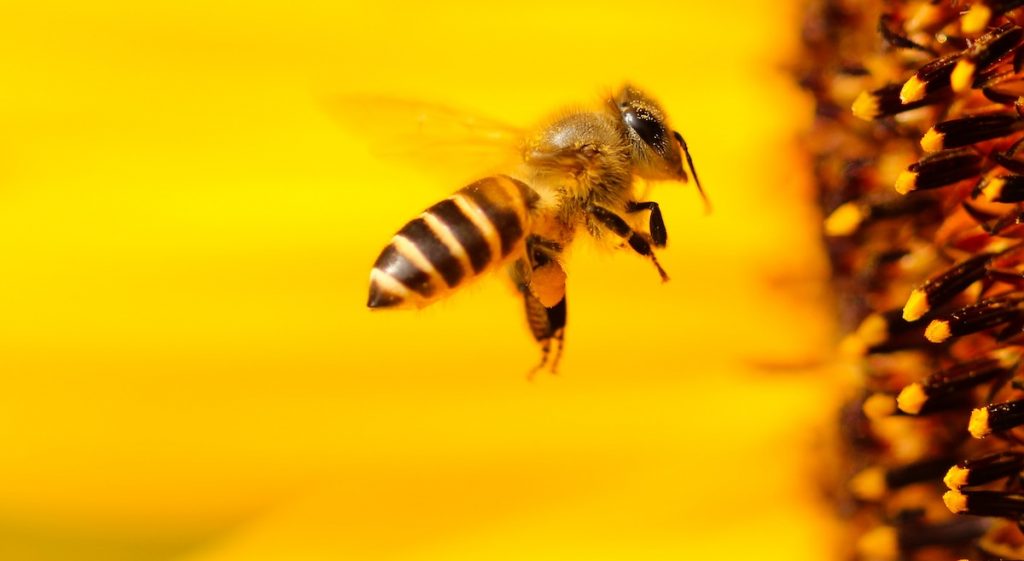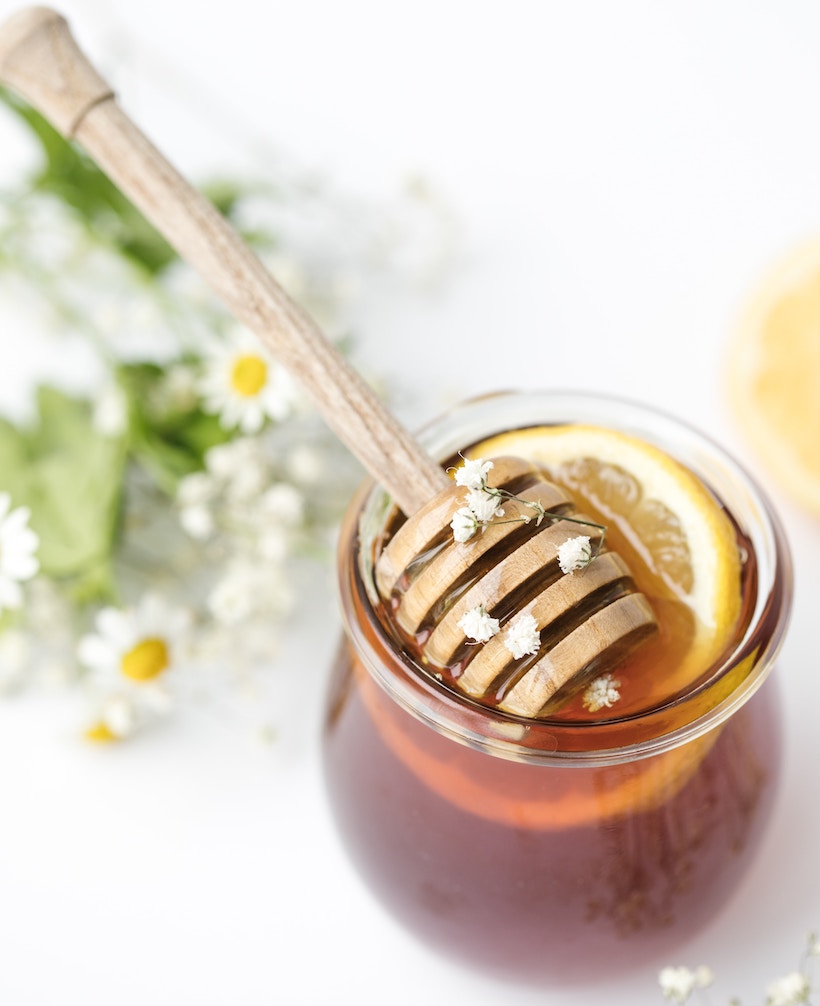
Do you ever stop and wonder about the mysteries of honey when you add it to your tea or incorporate it into a dish?
Honey is a fascinating substance. Sticky, sweet, and possibly even good for you.
It was enough to send me into a beehive of research to try to shine a light on the health effects of honey.
What is Honey? How is it Made and Collected?
Honey is a sweet, sticky, highly viscous liquid usually created by bees.

How is it made?
When you see bees hanging around plants, usually flowers, they aren’t only enjoying the scenery. Instead, they’re sucking out all delicious nectar, which is the sweet liquid plants make.
The bees store the nectar in an extra stomach, something that’s also referred to as a crop or sometimes honey stomach. Some nectar is broken down for long-term storage, so bees can use it as a form of energy or otherwise use it when their food supply is low. Otherwise, the nectar is mixed with other enzymes and stored.
Once bees return to their hive, they regurgitate the nectar to other bees working the hive. This process repeats a few times until bees regurgitate the nectar into a honeycomb. As it’s still liquid at that point, bees then team up to fan their wings at it and accelerate evaporation.
Once dry, bees seal the honeycomb with wax, stopping any fermentation and leaving fresh honey that can be stored away indefinitely.
Honey Isn’t Just From Nectar…
Flower nectar isn’t the only way this process can happen, though. Bees sometimes opt to use honeydew if they can’t get nectar.
Honeydew is a sweet liquid excreted by some insects when they feed on certain trees. Honeydew excretions usually land on leaves or underneath plants, and that’s where the bees suck it up like nectar.
Although bees treat honeydew just as they treat nectar, it does have some downsides. With a higher ash content than nectar, honeydew is an inferior food source for bees around wintertime – but it can still create honey nonetheless.
Honey’s History
Just as bees have an ancient history, so does honey itself. You can even find rock paintings of honey dating back thousands of years.
Other than being used as a sweetener, honey has a prominent history in folk medicine. Much of this is due to its proven antimicrobial properties.
Beyond that, you can discover honey’s history in various religious texts – it shows up everywhere from ancient Greek mythology to the Hebrew Bible.
How is honey used?
There are almost too many uses of honey to count. It’s used as a sweetening agent, as a food on its own, topically, or even as a medicine.
I’ll enumerate more ways later, but you can see honey’s beneficial health effects with some medical applications, for example treating burns or improving a cough.
Other than that, you can use it for its taste. Countless recipes call for honey from desserts like candy and cake to meals like glazing chicken and vegetables.
Honey can even be brought into your skincare routine.
Ingredients in Honey
Honey’s benefits stem from its complex makeup. It has a chemical composition where carbohydrates take up the most space. There are other ingredients in honey, too, of course, including vitamins and minerals, antioxidants, and proteins.
Pasteurized Honey
Pasteurized honey is the most common honey on the store shelf. Pasteurization carefully exposes honey to heat, which kills off yeast and various harmful microorganisms. Pasteurization also can help extend the shelf life.
For honey pasteurization, it’s usually heated to around 145°F (62.8°C). Pasteurized honey has a translucent-like color. It can also be darker or creamier than other varieties on the shelf.
Raw Honey
Raw honey is just as it sounds: it’s the honey as it exists within the beehive. To get this honey, it’s first lightly strained through a mesh cloth or similar filter to remove things such as beeswax and other impurities from the hive.
Some raw honey doesn’t even take a filtering step. These honey contain all the pollen the bees have collected as well as propolis, which is a glue-like substance that bees pick up from flower buds.
When compared to pasteurized honey, raw honey boasts more beneficial nutrients since no heat is applied to destroy the yeast. It’s known to have dozens of amino acids, minerals, and an excellent variety of vitamins. They are especially rich in polyphenols, which behave much like antioxidants.
Strained Honey
According to the USDA honey grading system, strained honey is honey that’s strained to remove the majority of particles and faults from the hive’s bounty. This includes defects, propolis, and honeycomb, but perhaps not every small air bubble or pollen grain.
Strained honey is sometimes confused or used interchangeably with raw honey because some raw honey (as explained before) goes through a light straining process.
Of course, strained honey as the USDA grades it aims to remove most of the substances from the final honey product. This process leaves a smoother liquid that’s lightly colored.
Filtered Honey
The most processed honey on a typical shelf is filtered honey. The USDA grading standards state filtered honey is honey filtered out to remove almost all of the pollen, air bubbles, and other impurities from the honey – a step even further than strained.
There are benefits to filtered honey, one of the main ones being longevity. The filtration process delays the natural crystallization that occurs, keeping the honey as a liquid longer.
It’s a bit rarer, but there’s also a technique referred to as ultrafiltration. This method isn’t widely used – it is expensive compared to other preparation methods. It involves adding water to honey, pressurizing the mix, then removing the water.
Ultrafiltration leaves behind a clear sweetener that isn’t exactly referred to as “honey” in the U.S. It does wind up removing the pollen and byproducts as well, which takes away many of the nutrients usually found in honey.
Antioxidants in Honey
One place where honey shines? Antioxidant content.
Researchers believe that honey contains similar antioxidant power to Vitamin C found in tomatoes.
There are numerous antioxidant enzymes in honey, such as glucose oxidase. You can even find several different polyphenols like caffeic acid and plenty of flavonoids in honey. It’s known that the darker honey appears, the higher the antioxidant content it has.
Sugars in Honey
Did you think that honey could be a good substitute for sugar? Well, it might stop you from adding table sugar to your tea, but the fact is honey already contains many different sugars.
Honey has fructose, glucose, sucrose, maltose, and an eclectic mix of a few others. Fructose is a sugar usually found in fruit, while glucose is what the body uses for energy when burning carbohydrates. Sucrose is your typical, everyday table sugar.
Minerals in Honey
Minerals are found in abundance in honey, with the most being potassium, phosphorus, and calcium.
The exact composition of minerals in honey varies based on the type of honey. For instance, honeydew honey will usually contain a higher mineral content than blossom honey.
Of course, all of the other factors in honey additionally influence the mineral content of honey: everything from hive habits to the flowers near the hive.

10 Health Benefits of Honey
1. Natural Antimicrobial
2. Improves Wound Healing
3. Honey’s Good for the Heart
4. Promotes Bone Health
5. Reduces Symptoms of Asthma and Bronchitis
6. Good for Oral Health (in Moderation)
7. Fights Against Allergies
8. Helps with Gut Health & Healing Ulcers
9. Active Against Some Cancers
10. Just as You Expected: Honey Fights a Cough
Negative Effects of Honey
- Botulism
- Grayanotoxins
- High Calorie and Sugar Content
- Bacterial or Fungal Infection
Is Honey Good for You?
I’ll answer with a measured yes: in my layman’s opinion, honey is okay for you in moderation – but due to its sugar content isn’t necessarily a “healthy food”.
I also would hedge that statement some: if you are immunocompromised or feeding an infant, avoid using honey (especially raw honey).

Honey and Your Health
After my research, I’m left with a sweet taste in my mouth – honey is undoubtedly an exciting substance.
From nectar (or honeydew) to your market’s shelf is such a fascinating journey, and its beneficial effects on the human body make honey all the more interesting.
So, the next time you drizzle honey on your pancakes or add it to your tea, take a second to appreciate the syrup and all it does. Honey deserves its golden color and positive reputation – I hope you enjoy it just a little bit more the next time you eat it.
by Gerard Paul
If you would like to read more, take a look original text at https://manyeats.com/health-effects-of-honey/
Photos sources:
https://manyeats.com/wp-content/uploads/2019/12/honeybee-approach-flower-1024×561.jpg
https://manyeats.com/wp-content/uploads/2019/12/person-break-apart-honeycomb.jpg
https://manyeats.com/wp-content/uploads/2019/12/honey-in-clear-jar.jpg
https://manyeats.com/wp-content/uploads/2019/12/honey-drip-on-pancakes.jpg
